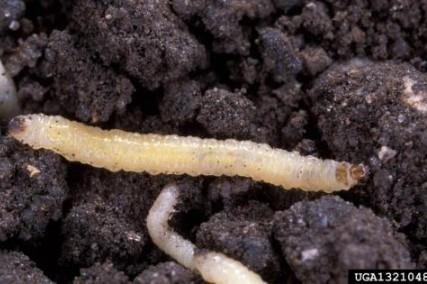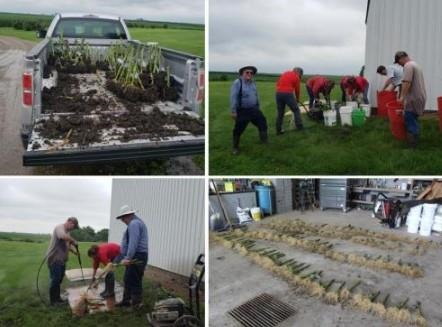By Ashley Dean and Erin Hodgson
Western and northern corn rootworm are serious pests of corn throughout the Corn Belt. We recommend that farmers scout every cornfield every year, regardless of the management tactic(s) used, to evaluate management decisions and prepare for next year. It is a good idea to scout for larvae early in the season, assess root injury when larval feeding wraps up, and monitor adults later in the season. Corn rootworm adults have started emerging throughout Iowa, which is an excellent time to evaluate root injury.
Scouting for larvae
In some areas, it may be too late to see larvae right now, but the float test is a good way to know if there are larvae (Photo 1) in the field and assess their size. Erin created a video this year describing the float test and what it means. Another method of sampling larvae is outlined in this blog post.

Photo 1. Corn rootworm larvae are slender, white, and appear to have two heads.
Assessing root injury
A good rule of thumb is to assess root injury when you see the first adults emerging in a field as this indicates that larval feeding is mostly complete. Usually, larval feeding wraps up in late June and the first adults are present in late June or early July. However, development was delayed by a few weeks this year due to the cool spring, and many areas are just now seeing the first adults emerging. Assessing root injury while it is fresh is best since some hybrids can compensate (Photo 2), which makes it difficult to assess injury later in the season.

Photo 2. Example of a corn root that had regrowth after corn rootworm injury in 2021. To see the pruned roots, we had to peel back the regrowth.
What you need: To assess root injury, you will need a spade, buckets with water, and a hose or power washer (Photo 3).
- Use the spade to dig roots from several areas of the field. Take care to dig at least 6 inches away from the stalk to ensure you get all the roots and do not injure roots.
- A representative sample of the field is best for making management decisions. If a field has multiple hybrids, treat each one as a separate field and evaluate root injury separately.
- Soak the roots in buckets of water; sometimes it is best to leave plants overnight if the soil is tough to get off. You can use your hands to remove soil but be careful not to break the roots.
- Once most of the soil is off, use a hose or power washer (on a setting that will not break the roots) to get the remaining soil off. It is important that the roots are clean so you can see any pruned roots.
- Use the ISU 0-3 Node Injury Scale (NIS) to assess root injury on nodes 4-6. It may be helpful to split the stalk to find these nodes if it is not obvious.
- Find node 6. Count the number of roots on the node that are pruned to within 1.5 inches of the stalk or soil line (for brace roots that were not entirely in the soil) and divide by the total number of roots on the node. For example: if six roots are pruned and there are 12 total roots on the node, that node gets a score of 0.5.
- Repeat for the next two nodes. Once you have scores for each of the three nodes, add them up. This will be the total score for that plant.
- Repeat Step 4 for each plant that was dug from the field. Average the scores to get a score for the field.

Photo 3. The root rating process. Plants are gathered from the field (upper left), then soaked in buckets (upper right) before being power washed clean (lower left). Clean roots are then ready to be rated (lower right).
What does it mean? Economic loss occurs with a NIS score of 0.25 (2-3 roots pruned). This is not typically a level of root feeding that would be visible aboveground, so digging roots is the best way to confirm that economic loss is not occurring. It is estimated that fields will experience 15% yield loss with each node pruned. Some fields regularly experience NIS scores of at least 2.0, which means they consistently lose at least 30% of their projected yield each year. If a Bt hybrid was used in the field and the average score exceeds 0.5, this is considered unacceptable by the Environmental Protection Agency (EPA) and would need to be investigated.
Why scout?
Farmers have several management tactics available for suppressing corn rootworm larvae, including soil-applied insecticides, Bt corn hybrids (including those with RNAi), and crop rotation. Although both species are persistent pests, western corn rootworm is particularly adaptable. The Gassmann Lab at Iowa State University (ISU) has confirmed western corn rootworm resistance to all four Bt rootworm traits in Iowa. Although not present in Iowa yet, North Dakota has confirmed northern corn rootworm resistance to Cry3Bb1 and Cry34/35Ab1, and Nebraska has confirmed western corn rootworm resistance to insecticides. Scouting for corn rootworm allows farmers to make management decisions for next year and will prolong the efficacy of the few management tactics we have for corn rootworm.
Source : iastate.edu